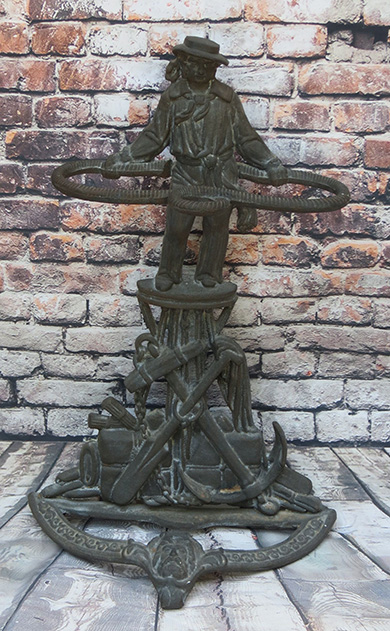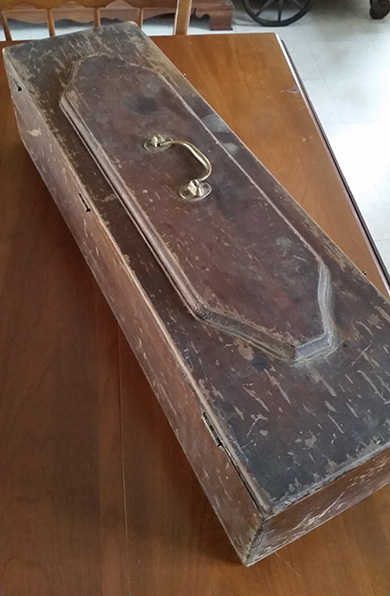 |
|
|||
 |
 |
|||
Copyright © Harry Rinker, LLC 2017 Questions
and Answers
QUESTION: I recently acquired a Jack Tar (nautical sailor) cast iron umbrella stand at an estate sale for $60.00. With the exception of missing the bottom metal drip tray, it is in fine condition. I researched the piece on the internet. I found two examples that sold at Skinner, one with a severely damaged base for $1,185.00 and a second with a great deal of rust for $1,896.00. Christies’s sold an example for $5,400.00. I have several questions. First, should I restore the bottom metal drip tray before selling it? Second, is it too good to sell on Craigslist or eBay? Third, if I decide to send it to auction, what advice do you have for me? –TM, Ada, Michigan, Email Question. 
ANSWER: Before answering your questions, it is necessary to analyze the auction results. First, a hammer bid and/or sale price does not reflect the amount received by a consigner. Several deductions are necessary: (1) the buyer’s penalty, (2) the auctioneer’s commission, and (3) added costs such as shipping, insurance, and payment to have the item pictured. A quick, but not always accurate, way to obtain the amount the consignor received is to deduct 30 percent from the reported price. Second, were there special circumstances involved? Was the Christie’s auction a nautical-themed auction, a single owner sale, or a sale where two sides of a family bid against each other, each determined to prevent the other from being the successful bidder? Third, what was the date and time of the sale? Some things sell better in the spring while others bring higher prices in the fall. How long ago were the sales? Given the overall condition of the Jack Tar umbrella stand, I would not restore the metal drip tray, even though restoring it might be inexpensive. Let the new owner assume the responsibility. Further, if a potential buyer sees one restoration, he/she becomes suspicious there may be other restorations he/she has not spotted. The fewer questions a piece raises, the higher the price it will bring. Decorating/conversation value is the primary value for the umbrella stand. It has a strong “WOW” factor. Decorators will love its strong statement. If there are any cast iron umbrella stand collectors, I am not aware of them. Its collecting appeal is to a nautical collector, who is likely to view it as a secondary not primary level item. The research you did indicates that the strongest market for your Jack Tar umbrella stand is large metropolitan coastal cities along the New England and Mid-Atlantic coast, a fact supported by the dress of the sailor. Since it is not complete, Christie’s most likely would reject the Jack Tar umbrella stand even though Christie’s received a strong price for the one it sold. In addition to Skinner, you might consider approaching James D. Julia Auctioneers in Fairfield, ME, and Doyle Galleries in New York City. Heritage Auctions in Dallas is another possibility. Heritage has a record of achieving strong prices for decorative/historic Americana. When negotiating contract terms with an auction house, make certain you understand all the charges. Because the value is low, expect to pay a sale premium of between 15 and 20 percent. As indicated earlier, there will be hidden charges, shipping and insurance to name a few. Given what you paid to buy the Jack Tar umbrella stand, do not set a reserve. You want to sell it. You do not want it back. Good luck. Once the piece is sold, email me, let me know what sale route you took, and what you actually received. Include the hammer price and the price with the buyer’s penalty if you wish. QUESTION: In going through my grandmother’s things, I found a wooden box that looks very much like a tool box. Planning on using it as a tack box, I was surprised to discover old photos, glass plates, glass plate negatives, and even some old chemicals. I wondered if the box had been carried on the side of a mule when a photographer traveled from town to town. Although I could not identify most of the photographs, there were scenes from Hog Island in New York and the Wharton School of Business at the University of Pennsylvania in Philadelphia. My grandfather attended Wharton after serving in France in WWI. Should I sell the contents or keep them? -- BH, State College, PA, Email Question 
ANSWER: Most likely, these supplies belonged to your grandfather. Early amateur photographers had plate cameras, prepared and developed their own plates, and printed the results. The slits on the side of the box indicate it was a storage box for large glass plates, perhaps 8-inches by 10-inches. Keep it and use it as a tack box. Hopefully, State College still has an “old fashion” camera studio or shop. Take your glass negatives and have contact prints made of them. Do not pay for enlargements. Once done, you will have a better idea of the images. Avoid handling the glass plates. Dead relative pictures and negatives have no value except to you and possibly not even then, especially if you cannot identify them. Identifiable scenic images are another matter. If you can identify the location, consider donating the negatives to a local historical society, such as the New York Historical Society, or institution, such as the Wharton School. Take a tax deduction of $50.00 to $75.00 for each negative donated. If you are in the 20 percent tax bracket, your tax break would be $10.00 or $15.00, far more than you are likely to get attempting to sell the negatives. Donate the negative boxes and other photograph material to your local historical society or swap it with the photographer who is contact printing the negatives. He/she can use it for display/conversation purposes. Attempting to sell any chemicals is tricky. My best advice is do not do it. There is a secondary market for old dry plate photograph plate boxes but the return is minimal, between $10.00 and $15.00. Boxes still containing the plates sell around $30.00. Finally, the contents of your box are an invitation to an adventure. Take the time and travel down its path. 
QUESTION: I have a framed black and white print entitled “COLUMBIA GIVES TO HER SONS/ THE ACCOLADES OF THE / NEW CHIVALRY OF HUMANITY.” On the bottom beneath the name Leonard Sword is “SERVED WITH HONOR IN THE WORLD WAR / AND DIED IN THE SERVICE OF HER COUNTRY” and a facsimile signature of Woodrow Wilson. The image show Columbia holding a proclamation above her head and with her other hand touching a sword to the shoulder of a World War I doughboy who kneels at her feet. A large sized US flag flies behind her along with the faces of other soldiers. It is framed. My husband purchased it for display in a World War I museum he is creating. What is it worth? – K, Birdsboro, PA ANSWER: Edward Howland Blashfield (1848-1936) designed the image in 1919. The print was widely distributed. A colored variation exists. The print has a large white border, often trimmed down to fit frames. Examples are readily available on the internet. Although I found a seller asking $125.00 for a framed example, sell through prices on WorthPoint.com range from $20.00 to $95.00. Value depends somewhat on the service record of the individuals. Those for females command a higher price than those for males. A solid sell through price for a framed example is between $45.00 and $55.00. QUESTION: When did non-stick surface pans arrive on the commercial scene? – G, Reading, PA ANSWER: Roy Plunkett, working on a joint venture for DuPont, discovered Teflon (polytetrafluoroethylene or PTFE) in 1938. During World War II, Teflon was used to make seals resistant to uranium hexafluoride gas used in the atomic bomb. In 1951, DuPont applied Telflon to commercial baking equipment. Use on home products was delayed because of the possibility of toxic gas from pans overheated in inadequately ventilated spaces. DuPont’s John Gilbert was tasked with solving the problem. He did. By the late 1950s, Teflon coated pots and pans were the rage on the range. [My apologies. The pun was simply too good to pass up.] Teflon is only one of several non-stick coatings. Today, its use is minimal. Early Teflon cookware has little to no collectibility. Harry L. Rinker welcomes questions from readers about
collectibles, those mass-produced items from the twentieth and twenty-first centuries.
Selected letters will be answered in this column.
Harry cannot provide personal answers.
Photos and other material submitted cannot be
returned.
Send your questions to: Rinker on Collectibles, 5955 Mill
Point Court SE, Kentwood, MI 49512.
You also can e-mail your questions to
harrylrinker@aol.com.
Only e-mails containing a full name and mailing address
will be considered.
You can listen
and participate in
WHATCHA GOT?, Harry’s
antiques and collectibles radio call-in show, on Sunday mornings between 8:00 AM
and 10:00 AM Eastern Time.
If you
cannot find it on a station in your area,
WHATCHA GOT?
streams live on the Internet at www.gcnlive.com.
SELL, KEEP OR TOSS?: HOW TO DOWNSIZE A HOME,
SETTLE AN ESTATE, AND APPRAISE PERSONAL PROPERTY
(House of Collectibles, an imprint of Random House Information Group, $17.99),
Harry’s latest book, is available at your favorite bookstore and via
www.harryrinker.com.
|
||||